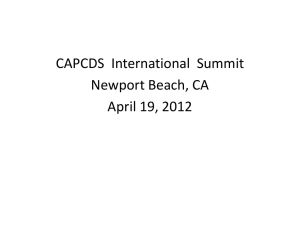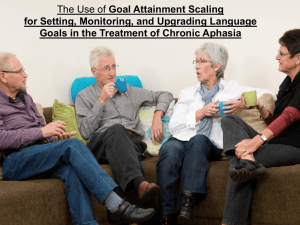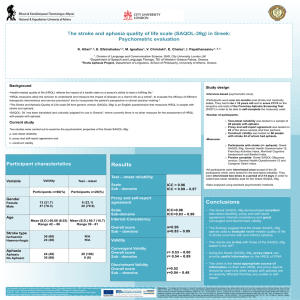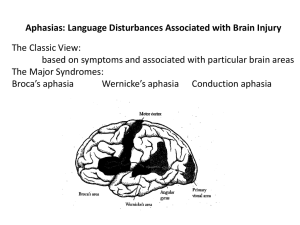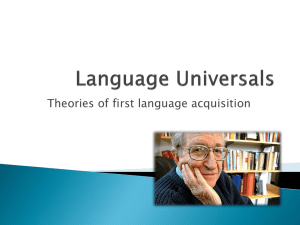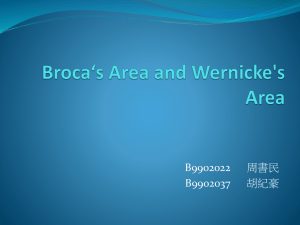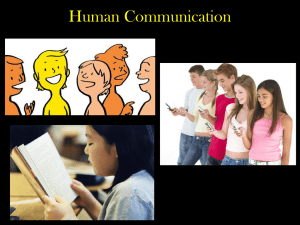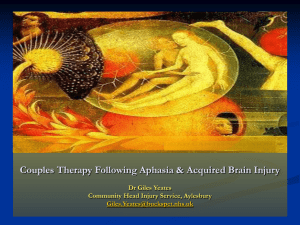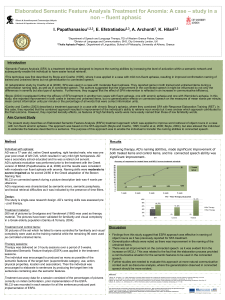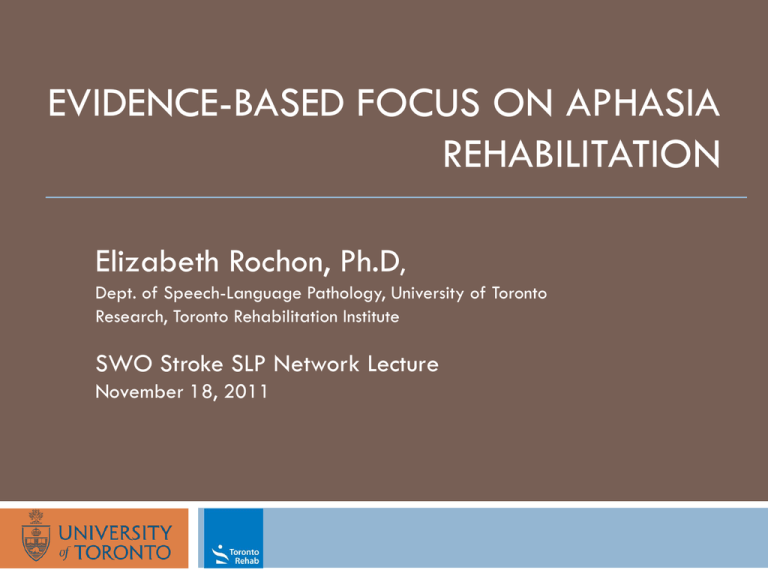
EVIDENCE-BASED FOCUS ON APHASIA
REHABILITATION
Elizabeth Rochon, Ph.D,
Dept. of Speech-Language Pathology, University of Toronto
Research, Toronto Rehabilitation Institute
SWO Stroke SLP Network Lecture
November 18, 2011
Outline
Different kinds of Research that informs clinical
practice
Phases of Clinical Research and levels of evidence
Aphasia Therapy- where do we stand?
Research that Informs Clinical Practice
Basic, Translational, Applied
Basic
Aims to increase scientific knowledge.
Is theoretical and aims to improve understanding of
behaviour under study.
Lays the foundation for applied research but does
not aim to solve or treat the phenomenon under
study.
E.g., what is the underlying nature of
paraphasic errors in naming in aphasia?
Research that Informs Clinical Practice
Basic, Translational, Applied
Translational
A bridge between basic and clinical research.
Aims to promote a “bench-to-bedside” approach.
Dependent Variables
Independent Variables
Acquisition
Generalization
Interference
Maintenance
Neural effects
Intensity
Timing
Quantity
Salience
Treatment
Neural conditions
Lexical semantics
Phonology
Orthography
Morphosyntax
Pragmatics/discourse/social
Linguistic Behaviours
(Raymer et al., 2008. Translational research in aphasia: from neuroscience to neurorehabilitation, JSHLR, 51, S259-S275)
Research that Informs Clinical Practice
Basic, Translational, Applied
Applied
Its basis is basic research.
Aims to address and solve a practical problem.
E.g., What is the most effective treatment for
naming disorders in aphasia?
Clinical (Translational and Applied) Research
Treatment Efficacy:
Best possible conditions (e.g., controlled environment, ideal
study population, etc.) to produce the best possible outcome.
Requires “overt and systematic control over all aspects of
the research.” (Robey, 2004, p. 402)
Treatment Effectiveness:
Benefit observed in the real world; is tested only after
efficacy has been established.
Refers to benefit provided: “in a typical fashion by typical
practitioners to typical patients in typical clinical settings”.
(Robey, 2004, p. 402)
Clinical (Translational and Applied) Research
Phase I: Exploratory studies
Phase II: Feasibility studies
Phase III: Clinical Trials
Phase IV: Effectiveness Research
Phase V: Cost-effectiveness and consumer satisfaction
(Robey et al. (2004). Report on the joint coordinating committee on
evidence-based practice, ASHA)
Adaptation of 5 Phases for Communication
Disorders & Sciences (Robey, 2004)
Phase I:
Selecting a therapeutic effect, establishing if present,
estimating magnitude (i.e., therapeutic effect = dependent
variable; treatment protocol = independent variable).
Benefit can be assessed at various levels of WHO model (a
single study cannot assess all levels)!
Examples of Phase I research questions:
Test to detect effect and establish effect sizes; define population;
delineate treatment protocol, estimate dose, etc.):
Examples of Phase I research designs:
Case and single-subject studies, small group pre-post studies,
retrospective studies.
Adaptation of 5 Phases for Communication
Disorders & Sciences (Robey, 2004)
Phase II:
“…Exploring the dimensions of the therapeutic effect and
making the necessary preparations for conduction of a
clinical trial.” (Robey, 2004, p. 404)
Examples of Phase II research tasks:
Establish presence and magnitude of efficacy; better define target
population; refine protocol, determine optimal dosage, refine
outcome measurements, etc.
Examples of Phase II research designs:
Hypothesis-testing single-subject studies, small group within-effect,
case-control and cohort-control studies; measurement studies re:
outcome measures.
Adaptation of 5 Phases for Communication
Disorders & Sciences (Robey, 2004)
Phase III:
Efficacy is tested via a clinical trial.
Phase III research design:
A parallel-groups design (treatment condition vs.
control condition).
Gold standard is randomized controlled trial (RCT).
(e.g., treatment vs. control condition, random
allocation, concealment, power calculation, etc.,)
Adaptation of 5 Phases for Communication
Disorders & Sciences (Robey, 2004)
Phase IV:
Field research to determine applicability in clinical practice.
Examples of Phase IV research tasks:
Test effectiveness in target and sub-populations; test
effectiveness of different service delivery models or variants
of treatment protocol; meta-analyses.
Examples of Phase IV research designs:
Pre-post studies; parallel-groups and hypothesis-driven
single-subject studies.
Adaptation of 5 Phases for Communication
Disorders & Sciences (Robey, 2004)
Phase V:
Determine the benefits and the costs of the
treatment.
Cost-effectiveness studies and cost-benefit
analyses.
Audience at this stage includes administrators,
policy makers, etc.
What is Evidence-Based Practice (EBP)?
A process of clinical decision-making that entails:
“The integration of best research evidence with clinical
expertise and patient values” (Sackett et al., 2000, in Johnson, 2006)
Current Best Evidence
EBP
Clinical Expertise
Client/Patient Values
EBP Requires…..
A “show me the data” attitude
i.e., sound scientific evidence might contradict opinions of authorities.
A focus on aspects of research relevant to practice
i.e., clinically relevant questions using appropriate methodology.
Rigorous criteria to judge the quality of the evidence
i.e., in the domains of validity; importance; precision.
(Dollaghan, 2004 in Johnson, 2006)
5 Key Steps in EBP
Pose an answerable question.
Search for the evidence.
Critically appraise the evidence for its validity and relevance.
Make a decision by integrating the evidence with clinical
experience and patient/client values.
Evaluate performance after acting on the evidence.
(from Johnson, 2006, p. 21, as per the Canadian Cochrane Network)
Levels of evidence for studies of
treatment efficacy
Levels
Ia
Description
Well-designed meta analysis of >1 randomized controlled
trial
Ib
Well-designed randomized controlled study
IIa
Well-designed controlled study without randomization
IIb
Well-designed quasi-experimental study
III
IV
Well- designed correlational studies i.e., correlational and
case studies
Expert committee report, consensus conference, clinical
experience of respected authorities
(From ASHA 2004 in Johnson, 2006)
Challenges to Implementation of EBP
Evidence may not be available or be of low quality.
Answers to complex clinical questions are never black and
white.
Approaches and premises from medicine may not transfer
easily to SLP.
Finding time to implement EBP.
Ensuring comprehensive searches.
Ensuring adequate critical appraisals.
(see Johnson, 2006)
Levels of evidence for studies of
treatment efficacy
Systematic reviews:
Identifies completed studies related to a specific research
question
Evaluates results and arrive at a conclusion
Use a well-defined uniform approach
Useful for developing practice guidelines
Meta-analysis:
Statistical aspect of systematic review
Summary estimate and confidence interval calculated
Together individual study findings are combined to determine the
effectiveness of an intervention
Aphasia Therapy: What have we
learned from meta-analyses?
I.
Robey, 1998: The “weight of scientific evidence” bearing on:
The effectiveness/efficacy of aphasia treatments
considering: pre-post effects and treatment vs. no treatment
studies.
Improvement in therapy considering: amount and type of
therapy; severity and type of aphasia.
N= 55 quasi-experimental studies
Aphasia Therapy: What have we
learned from meta-analyses?
Results (Robey, 1998)
Recovery is superior for treated vs. untreated individuals
at all stages of recovery (especially acute).
For optimal gains, treatment dosage of 2 + hours per
week is better than shorter treatment duration.
Large treatment gains found for persons with severe
aphasia.
Schuell-Wepman-Darley multimodal stimulation approach
resulted in a large effect size (too few examples of other
specific treatment approaches to analyze).
Aphasia Therapy: What have we
learned from meta-analyses?
II.
Results (Bhogal et al., 2002)
Intensive treatment (i.e., more hours per week) yields
better outcomes).
E.g., half of the +ve studies provided an average of 8.8
hours/week for 11.2 weeks.; -ve studies provided
approximately 1 hour/week for 22.9 weeks.
Total hours of therapy were greater in more intense
studies.
“Intensive therapy delivered over 2 to 3 months is critical
to maximizing aphasia recovery….” (p. 991).
(n=10 controlled trials, i.e., treatment vs. control condition)
Aphasia Therapy: What have we
learned from meta-analyses?
III.
Cappa et al., 2005:
Class II, Class III and rigorous single-case studies indicate
probable effectiveness : grade B recommendation.
A need for further investigation in the field.
(European Federation of Neurological Societies, Task Force on Cognitive Rehabilitation)
Aphasia Therapy: What have we
learned from a Cochrane Review?
IV.
Speech and language therapy for aphasia
following stroke (Brady & Enderby):
Randomized controlled trials (RCTs)
Speech therapy vs. no speech therapy
Speech therapy vs. social support/stimulation
SLP intervention 1 vs. SLP intervention 2
(The Cochrane Collaboration, 2010)
Aphasia Therapy: What have we
learned from a Cochrane Review?
Trend favouring intensive over conventional therapy
But significantly more people withdrew from intensive vs.
conventional therapy
When therapy is delivered by a therapist-trained and
supervised volunteer appears to be as effective as when
delivered by a professional.
Not enough evidence to adjudicate between therapy
approaches.
(The Cochrane Collaboration, 2010)
Aphasia Therapy: What have we
learned from a Cochrane Review?
Authors note:
Much variability in quality of the evidence (i.e., many, if
not most, studies not designed as true clinical trials).
E.g., randomization methodology and methods for
concealing allocation, power size calculation,
intention-to-treat analysis
(The Cochrane Collaboration, 2010)
Aphasia Therapy: What have we
learned from a Cochrane Review?
“..there may be a benefit from speech and language therapy
but there was insufficient evidence to indicate the best
approach to delivering speech and language therapy.” (p.2)
Evidence noted especially for functional communication,
expressive language and the severity of aphasia.
(The Cochrane Collaboration, 2010)
Aphasia Therapy: What have we learned
from meta-analyses?
V.
Cicerone et al., 2011
No advantage for intensive therapy in acute stage
CILT and training in everyday communication > CILT
alone
Semantic & phonological treatment equally
effective: treatment-specific effects demonstrated
Aphasia Therapy: What have we learned
from meta-analyses?
VI.
Snell et al., 2010
Results not linked to number of items given in
therapy
Empirical study: severity of anomia need not
determine how many items given in therapy
Aphasia Therapy: What have we learned
from systematic reviews?
VII.
Farqi-Shah et al., 2010
Treatment in L2 yields similar outcomes to treatment
in L1.
Cross-language transfer occurred in most studies
Conclusion limited by methodological quality of
studies (n=14)
Aphasia Therapy: What have we learned
from systematic reviews?
VIII.
Simmons-Mackie et al., 2010
Training communication partners improves their
communication activities and/or participation.
Training communication partners is probably effective at
improving communication activities and/or participation of
persons with aphasia.
Insufficient evidence: acute aphasia; or, impact on language
impairment, psychological adjustment, or QOL .
Aphasia Therapy: What have we learned from an
evidence-based practice database (PsychBITE)?
IX.
Aphasia Therapy: What have we learned from an
evidence-based practice database (PsychBITE)?
IX.
Psychological database for Brain Impairment Treatment
TM
Efficacy (PsycBITE ; www.psycbite.com)
TM
(PsycBITE is modeled on PEDro; used in physio, OT, and SLP
TM
via speechBITE : www.speechbite.com
Includes 5 designs:
Systematic reviews (SR)
RCTs
Non-RCTs (NRCT)
Case series (CS)
Single-Subject designs (SSD)
(Togher et al., 2009)
Aphasia Therapy: What have we learned from an
evidence-based practice database (PsychBITE)?
Levels of Evidence:
Class I: Evidence provided by one or more well
designed RCTs
Class II: Evidence provided by 1 or more
observational study with concurrent controls.
Class III: Evidence provided by expert opinion, case
series, case reports.
Aphasia Therapy: What have we learned from an
evidence-based practice database (PsychBITE)?
Up to September, 2007, n=339 aphasia
treatment
Systematic reviews
RCTs
Non-RCTs
Case series
Single-Subject designs
(Togher et al., 2009)
3%
7%
5%
15%
70%
Criteria Comprising The Pedro Scale
(Herbert et al., 1998/99 in Togher et al., 2009)
1. Eligibility criteria of subjects were specified (not included in
MQR Score)
2. Subjects were randomly allocated to interventions (in a
crossover study, subjects were randomly allocated an order in
which treatments were received)
3. Allocation was concealed
4. The intervention groups were similar at baseline regarding the
most important outcome measures and prognostic indicators
5. There was blinding of >95% of subjects
6. There was blinding of >95% of therapists who administered
the therapy
Criteria Comprising The Pedro Scale
(Herbert et al., 1998/99 in Togher et al., 2009)
7. There was blinding of >95% of assessors who measured at
least one key outcome
8. Measures of at least one key outcome were obtained from
>85% of the subjects initially allocated to groups
9. All subjects for whom outcome measures were available
received the treatment or control condition as allocated or,
where this was not the case, data for at least one key outcome
were analysed by ‘‘intention to treat’’
10. The results of between-intervention-group statistical
comparisons are reported for at least one key outcome
11. The study provides both point measures and measures of
variability for at least one key outcome
Aphasia Therapy: What have we learned from an
evidence-based practice database (PsychBITE)?
Mean MQR (methodological quality rating) based
on PEDro scale:
RCTs
Non-RCTs
4.4/10
2.6/10
(Maximum score: RCTs=10; NRCT=8; cannot rate CS and SSD)
Aphasia Therapy: What have we learned from an
evidence-based practice database (PsychBITE)?
Conclusion:
Methodological quality is modest
sources of bias are not sufficiently well controlled
Is this a problem with reporting or with the design and
methodology?
Above criteria need to be taken into account when
designing, executing and reporting aphasia treatment
research.
(Togher et al., 2009)
Aphasia Therapy: What have we learned from an
evidence-based practice database (PsychBITE)?
Examples of More Highly Rated Studies in PEDro:
Denes et al. (1996). Intensive versus regular speech therapy
in global aphasia: a controlled study.
Doesborgh et al. (2004a). Cues on request: The efficacy of
multicue, a computer program for word finidng therapy.
Doesborgh et al. (2004b). Effects of semantic treatment on
verbal comunication and linguistic processing in aphasia after
stroke: A randomized controlled trial.
Aphasia Therapy: What have we learned from an
evidence-based practice database (PsychBITE)?
Examples More Highly Rated Studies in PEDro:
Huber et al. (1997). Piracetam as an adjuvant to language
therapy for aphasia: A randomized double-blind placebocontrolled pilot study.
Kagan et al. (2001). Training volunteers as conversation
partners using “Supported conversation for adults with
aphasia” (SCA): A controlled trial.
Aphasia Therapy: What have we learned from
single-subject designs (SCED Scale)?
X.
SCED scale developed by Tate et al. (2008) to
determine quality of SSDs.
SSDs entail: systematic observation; manipulation of
variables of interest, repeated measurement, data
analysis.
Can be applied to clinical practice
Systematic approach to evaluation of SSDs would be
useful for EBP!
The SCED Scale
Rating Scale for Single Participant Designs
1. Clinical history was specified. Must include Age, Sex,
Aetiology and Severity.
2. Target behaviours. Precise and repeatable measures that
are operationally defined. Specify measure of target
behaviour.
3. Design 1: 3 phases. Study must be either A-B-A or multiple
baseline
4. Design 2: Baseline (pre-treatment phase). Sufficient
sampling was conducted
5. Design 3: Treatment phase. Sufficient sampling was
conducted
http://www.psycbite.com/docs/The_SCED_Scale.pdf
The SCED Scale
Rating Scale for Single Participant Designs
6. Design 4: Data record. Raw data points were reported
7. Observer bias: Inter-rater reliability was established for at
least one measure of target behaviour
8. Independence of assessors
9. Statistical analysis
10. Replication: either across subjects, therapists or settings
11. Evidence for generalisation
http://www.psycbite.com/docs/The_SCED_Scale.pdf
What have we learned from singlesubject designs (SCED Scale)?
Tate et al. (2008) showed that SCED Scale is valid and
reliable.
A standardized and systematic approach to evaluation of
SSDs would be useful for EBP.
Scales can be used to evaluate quality of SSD articles you
read!
What have we learned about Aphasia
Therapy: Summary
Quality of studies is variable to poor
Some evidence for efficacy/effectiveness for:
Word finding treatment
Supported conversation
Benefits of intensive treatment
Treatment for severe aphasia
Conclusion
Treatment research needs to better adhere to conventions
of clinical research, recognizing that:
Basic research is still necessary in the field to inform
applied research.
Many studies are/will still be efficacy/Phase I or II studies.
Impediments exist to implementation (i.e., small numbers of
appropriate subjects).
Single-subject designs will continue to provide good
evidence.
Improvements will benefit our clients and the field!
Questions?
THANK-YOU

